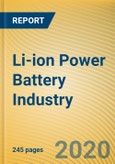Amid the thriving development of new energy vehicles, a total of 2,209,831 electric vehicles were sold globally in 2019, a year-on-year spurt of 14.5% and as a percentage of 2.5% in total automobile sales. Especially, Tesla surpassed BYD to rank first in the world with the highest sales up to 367,820 new energy vehicles in 2019, a 16.6% share of the global total.
China, the world's largest new energy vehicle producer and seller, sold 1.206 million NEVs in 2019, dipping by 4% year on year with the ramp-down in subsidies for new energy vehicle and occupying 4.68% of the global total, including 972,000 battery electric vehicles with a year-on-year decrease of 1.2% and 232,000 PHEVs with an annualized drop of 14.4%.
In 2019, a total of 1,059,733 new energy passenger cars were sold in China, encompassing 853,492 battery electric cars and 206,241 plug-in hybrid cars. In this field, the sales champion BYD contributed 227,232 units or 21.4% of the total in 2019.
The boom of global new energy vehicles gives impetus to lithium-ion power battery industry whose shipments swelled 16.6% over the previous year to 116.6GWh in 2019.
Five Chinese companies, namely CATL, BYD, AESC (acquired by Envision), Guoxuan High-tech (Gotion) and Lishen Battery rank among top the 10 battery companies by shipments. CATL has become the global champion by power battery shipments for three consecutive years, with its shipments posting 32.5GWh in 2019 with an upsurge of 30.5% year on year, and sweeping 27.9 percent of global shipments.
In 2019, 62.28GWh power lithium batteries were installed in China, rising by 9.3% from a year earlier. Assuming the output of new energy vehicles is 5.9 million units in 2025, the demand for power batteries will reach 330.6GWh with a CAGR of 32.1% from 62.28GWh in 2019.
In China, power batteries are led by ternary battery. The installed capacity of ternary batteries offered by 64 companies for the Chinese new energy vehicle market escalated 22.4% year on year to 40.92GWh in 2019, accounting for 65.7% of the total installed capacity (nearly 7 percentage points higher than that in 2018). The installed capacity of LiFePO4 power batteries provided by 38 companies fell by 6.4% to 20.26GWh, occupying 32.5% of the total installed capacity (down about 6 percentage points from 2018). The installed capacity of other types of power batteries was 1.11GWh, making up 1.8% of the total.
Highlights in the report:
This product will be delivered within 3-5 business days.
China, the world's largest new energy vehicle producer and seller, sold 1.206 million NEVs in 2019, dipping by 4% year on year with the ramp-down in subsidies for new energy vehicle and occupying 4.68% of the global total, including 972,000 battery electric vehicles with a year-on-year decrease of 1.2% and 232,000 PHEVs with an annualized drop of 14.4%.
In 2019, a total of 1,059,733 new energy passenger cars were sold in China, encompassing 853,492 battery electric cars and 206,241 plug-in hybrid cars. In this field, the sales champion BYD contributed 227,232 units or 21.4% of the total in 2019.
The boom of global new energy vehicles gives impetus to lithium-ion power battery industry whose shipments swelled 16.6% over the previous year to 116.6GWh in 2019.
Five Chinese companies, namely CATL, BYD, AESC (acquired by Envision), Guoxuan High-tech (Gotion) and Lishen Battery rank among top the 10 battery companies by shipments. CATL has become the global champion by power battery shipments for three consecutive years, with its shipments posting 32.5GWh in 2019 with an upsurge of 30.5% year on year, and sweeping 27.9 percent of global shipments.
In 2019, 62.28GWh power lithium batteries were installed in China, rising by 9.3% from a year earlier. Assuming the output of new energy vehicles is 5.9 million units in 2025, the demand for power batteries will reach 330.6GWh with a CAGR of 32.1% from 62.28GWh in 2019.
In China, power batteries are led by ternary battery. The installed capacity of ternary batteries offered by 64 companies for the Chinese new energy vehicle market escalated 22.4% year on year to 40.92GWh in 2019, accounting for 65.7% of the total installed capacity (nearly 7 percentage points higher than that in 2018). The installed capacity of LiFePO4 power batteries provided by 38 companies fell by 6.4% to 20.26GWh, occupying 32.5% of the total installed capacity (down about 6 percentage points from 2018). The installed capacity of other types of power batteries was 1.11GWh, making up 1.8% of the total.
Highlights in the report:
- Economic environment and policy climate for lithium power battery industry
- Lithium power battery industry chain (key materials, battery cells, packaging and BMS)
- Global and China new energy vehicle industry
- Global and China lithium power battery industry (demand, price, market size and competitive pattern)
- 5 global and 11 Chinese lithium power battery companies (technology, customers, lithium power battery business, capacity and production & sales).
This product will be delivered within 3-5 business days.
Table of Contents
1. Overview of Li-ion Power Battery
2. Market Environments for Li-ion Power Battery Industry
3. Li-ion Power Battery Industry Chain
4. Global New Energy Vehicle Market
5. Global Li-ion Power Battery Industry
6. Major Li-ion Power Battery Manufacturers in South Korea
7. Major Li-ion Power Battery Manufacturers in Japan
8. Major Power Battery Manufacturers in China
Companies Mentioned
- LG Chem
- Samsung SDI
- SK Innovation (SKI)
- Panasonic
- AESC
- LEJ
- BYD
- CATL
- Tianjin Lishen
- Beijing Hezhong Pufang New Energy Technology Co., Ltd.
- Wanxiang Group
- China Aviation Lithium Battery (CALB)
- Guoxuan High-tech
- OptimumNano
- Coslight
- Microvast Power Systems
Methodology

LOADING...








